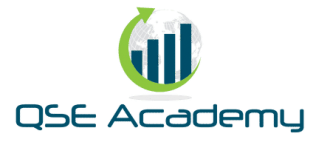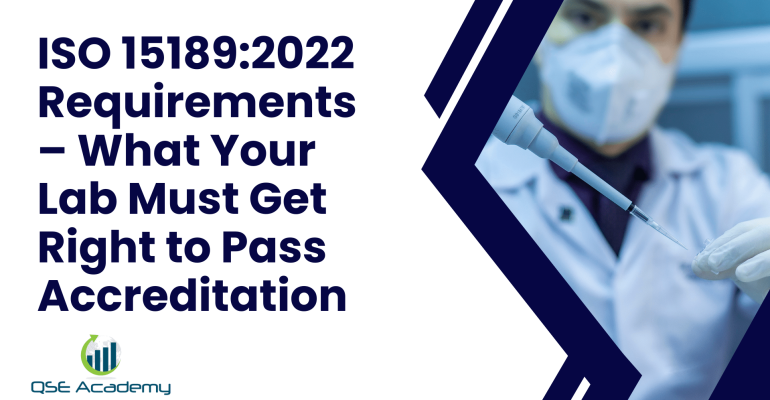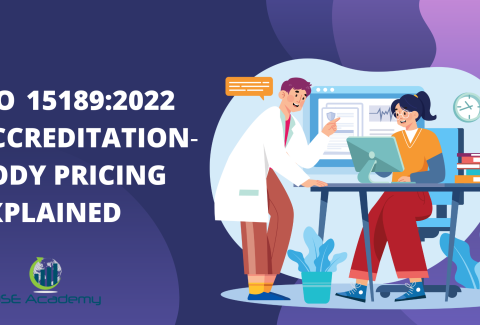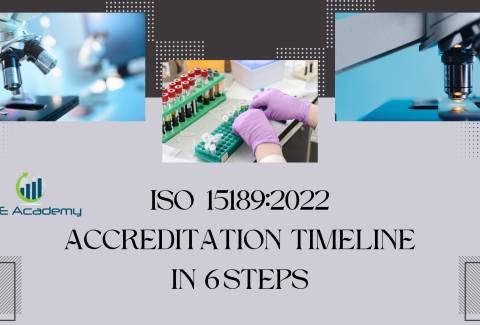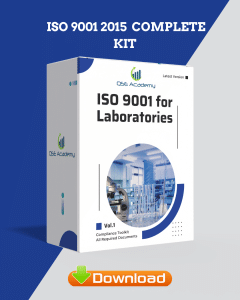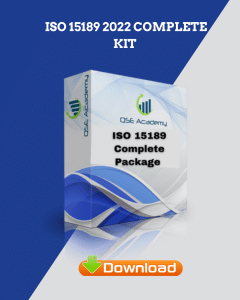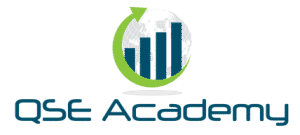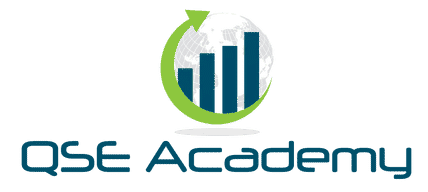ISO 15189:2022 Requirements
Last Updated on October 22, 2025 by Hafsa J.
ISO 15189:2022 Requirements – What Your Lab Must Get Right to Pass Accreditation
Let’s get real—navigating ISO 15189:2022 isn’t just about ticking boxes on a checklist. It’s about making sure your medical lab actually runs better, serves patients safely, and avoids that dreaded feeling of panic right before an accreditation audit.
In my experience working with clinical labs around the world—some just starting out, others going through major transitions—one thing always stands out: most labs aren’t totally sure what’s changed in this 2022 version or where they should focus first. And I get it. Between patient loads, team training, and quality reviews, who has time to decode standards line by line?
That’s exactly why I put this guide together. You’re going to get a clear breakdown of what your lab absolutely must get right to pass ISO 15189:2022 accreditation—without the fluff, without the overwhelm. We’ll walk through the most critical updates, highlight where labs often slip up, and I’ll even share a few hard-earned lessons from the field that might just save your next audit.
Sound good? Let’s dive in.
Understanding the Core Purpose of ISO 15189:2022
Before we dive into the technical stuff, let’s zoom out for a second.
At its core, ISO 15189:2022 isn’t just about compliance—it’s about competence. It’s about making sure your lab produces reliable results that doctors and patients can trust. This latest version tightens the focus on quality, risk, and continual improvement—not just paper trails.
So, what’s actually different in the 2022 version?
Here’s what I’ve noticed while helping labs transition from the 2012 standard:
-
It aligns with ISO’s “High-Level Structure” (that’s the same framework used in ISO 9001:2015 and ISO 17025). So, if your lab is juggling multiple standards, things just got a little simpler.
-
There’s more emphasis on risk-based thinking—not just handling problems after they happen, but actively looking for ways to prevent them.
-
Terms like “competence” and “impartiality” get more attention. This means your team’s qualifications and ethical integrity are no longer just a side note—they’re front and center.
Why this matters:
I had a client—a small but busy diagnostics lab—who thought they were in good shape because they hadn’t had any major complaints in years. But during their transition audit, the assessor flagged a lack of documented risk assessments and vague competence criteria for technicians. They weren’t doing anything wrong, but they couldn’t prove they were doing it right.
That’s the heart of ISO 15189:2022.
It’s not just about how well your lab performs. It’s about showing, with evidence, that your lab is structured to consistently deliver accurate, timely, and impartial results.
New Structure and Terminology You Must Get Right
Here’s the deal—if you’re still organizing your quality manual the old ISO 15189:2012 way, it’s time for a serious makeover. The 2022 revision introduced a brand-new structure based on ISO’s High-Level Structure (HLS). That might sound technical, but it basically means ISO is trying to make all its management standards speak the same language.
What does that mean for you?
You’ll now see sections like:
-
Context of the organization
-
Leadership
-
Support
-
Operation
-
Performance evaluation
-
Improvement
This isn’t just a cosmetic change. It shifts how your lab thinks about quality—from a reactive, document-heavy system to one that’s strategic, risk-aware, and focused on continual improvement.
Here’s what I’ve seen in practice:
One of my clients—a national pathology lab—initially tried to “translate” their old documentation into the new format. But they ended up with a Frankenstein system: mismatched terms, repeated sections, and confused staff. We scrapped it, started fresh with the HLS flow, and not only did it pass audit, it made training way easier for new hires.
Let’s clear up a few terms that often trip labs up:
-
Risk-Based Thinking
This doesn’t mean setting up a full-blown enterprise risk program. It’s about building the habit of asking, “What could go wrong here, and how do we prevent it?” Then putting that thinking into your procedures and reviews. -
Impartiality
It’s not just about obvious conflicts of interest. It’s about recognizing subtle pressures—like internal deadlines or client demands—that might influence results. You need to show how your lab stays neutral, even under pressure. -
Competence
Saying someone’s trained isn’t enough anymore. ISO 15189:2022 wants evidence—think task-based evaluations, observations, and actual performance metrics. It’s about verifying people can do the job, not just that they attended a training.
Quick Tip: Structure Smart from the Start
Don’t just try to patch your old manual to fit the new layout. Use the updated ISO 15189 clause structure as your framework. It makes audits smoother and helps your team understand how everything connects.
Key Requirements for Management System Compliance
Here’s where things start to make or break your accreditation.
ISO 15189:2022 expects your lab to run like a well-oiled machine—not just when auditors are watching, but every day. That’s where the management system comes in. It’s not just about having documents on file. It’s about creating a system that helps your team do the right thing consistently and catch issues before they escalate.
So, what does your lab really need to get right?
-
Documented policies and procedures
Your lab needs to clearly outline what it does, how it does it, and who’s responsible. And yes, these documents should match the new structure. But more importantly, they should reflect what’s actually happening in your lab—not some idealized version that lives in a binder nobody touches. -
Defined objectives and performance monitoring
It’s not enough to say, “We aim for high-quality results.” ISO expects you to define measurable objectives—like turnaround times, error rates, or staff competency—and regularly review your performance against them. -
Control of documents and records
This is an area that still trips up a lot of labs. You need clear version control, access restrictions, and a way to ensure outdated procedures don’t accidentally get used. The system has to be tight but not so rigid it slows people down. -
Internal audits and management review
These aren’t just formalities. They’re where you check if your system works and decide how to make it better. The standard wants to see real analysis here—trends, risks, improvements—not just “no findings” reports.
From My Experience
I once worked with a mid-sized diagnostic lab that had a beautiful-looking manual but zero follow-through. Procedures weren’t being followed, internal audits were copy-pasted each year, and staff had no idea what the quality objectives even were. We rebuilt their system to focus on actual workflows, created dashboards to track objectives in real time, and ran internal audits that led to real improvements. The result? A clean accreditation with no nonconformities—and way less stress.
Pro Tip: Keep It Practical
Build your management system around what actually happens in your lab. Then layer in compliance—don’t build a system for auditors that your staff can’t use day to day.
Personnel Competence and Training Programs
Let’s be honest—your lab is only as good as the people running it. ISO 15189:2022 makes that crystal clear. You can have the best equipment, the most polished SOPs, and spotless documentation—but if your staff isn’t competent and consistently trained, you’re going to run into serious problems during accreditation.
What ISO 15189:2022 expects:
-
Defined competence requirements
For every role—from sample reception to final report sign-off—you need to clearly define what “competent” looks like. That includes education, experience, training, and even soft skills if they impact quality. -
Ongoing assessments, not just one-time training
It’s not enough to tick off “training completed” on a checklist. ISO wants to see how you verify someone’s ability to perform tasks over time. Think hands-on assessments, peer observations, and periodic re-evaluations. -
Records that actually mean something
You need training and competency records that show growth, not just attendance. This could include assessment scores, error trends, or improvement actions taken after training gaps are identified.
What I’ve Seen That Works
A client of mine—an infectious disease testing lab—used a basic Excel sheet to track technician training. It listed course titles and dates, but no evidence of how well the techs were performing. During a pre-audit review, we built a real system: task-specific competence matrices, supervisor sign-offs, and post-training evaluations. The auditor called it one of the cleanest personnel systems they’d seen.
And more importantly? Staff actually felt supported. They knew what was expected and where they needed to grow.
Quick Insight: Make Competency Ongoing
Don’t treat competence as a checkbox during onboarding. Make it a living part of your quality system—with built-in reviews, refreshers, and peer coaching.
Risk Management and Continual Improvement
This is where ISO 15189:2022 takes things to the next level.
In the past, you could get away with fixing problems after they happened. Now, the standard expects you to think ahead—to spot risks before they become failures and to build a culture that doesn’t just react, but improves constantly.
Here’s what your lab needs to do:
-
Identify and evaluate risks proactively
You need a system for regularly asking, “What could go wrong here?” That applies to everything—from sample handling to staff scheduling to external service providers. The goal isn’t to create a mountain of paperwork, but to build a mindset where risk awareness is just part of how your lab operates. -
Document risk controls and decisions
You don’t need a complex system. A simple risk log or section in your management review will do. What matters is that you’ve thought through the risks, chosen how to address them, and can explain why. -
Continual improvement isn’t optional
ISO 15189:2022 wants to see that you’re learning from errors, audit findings, feedback, and even ideas from your own staff. And that you’re making real, traceable improvements—not just vague promises.
From the Field
I worked with a molecular diagnostics lab that had several recurring issues with delayed result reporting. They’d fix each incident but never looked at the root causes. When we dug into it, the delays were tied to equipment maintenance scheduling and staff fatigue during peak hours. Once we built risk tracking into their weekly planning, delays dropped—and so did stress levels.
This is what ISO means by continual improvement: small, smart changes that reduce risks and make your lab run better.
Pro Tip: Don’t Overcomplicate Risk Management
Start small. List out five key areas where problems could have serious consequences. Think about what you’re doing to prevent those issues—and write it down. That alone shows proactive thinking and satisfies a big chunk of the standard.
Equipment, Facilities, and Environmental Control
Now we’re getting into the nuts and bolts of how your lab runs day to day. ISO 15189:2022 puts serious emphasis on making sure your equipment works properly, your environment is controlled, and your records are airtight.
Why? Because even the most competent staff can’t produce reliable results if the tools they’re using are poorly maintained or the testing environment is unstable.
Here’s what you need to focus on:
-
Equipment must be calibrated, verified, and maintained
Every piece of critical equipment needs a documented maintenance plan, calibration schedule, and performance verification process. And yes, you need records—because if it’s not documented, it didn’t happen. -
Environmental conditions must support valid results
ISO expects you to monitor and control things like temperature, humidity, airflow, and lighting—especially in areas where they could impact test outcomes. If your PCR room gets too warm in the afternoons, that’s a problem. -
Facilities should support safe, efficient workflows
This includes designated clean zones, proper separation of high-risk areas, and layouts that minimize contamination. And while the standard doesn’t dictate exact floor plans, it does expect you to show that your setup makes sense for your testing scope.
What I’ve Seen Work in Real Labs
One midsize clinical lab I worked with had great procedures but struggled with equipment downtime. They relied on paper logs, and maintenance tasks were often delayed or missed. We switched them to a shared digital tracker with automated reminders. It wasn’t fancy, but it reduced breakdowns and helped them catch calibration drifts early—which their assessor specifically praised.
Environmental control can also catch you off guard. I’ve seen labs lose points for not having temperature monitoring in reagent storage rooms or failing to respond to minor air handling issues that later affected test stability.
Quick Tip: Go Digital Where It Matters
Use simple tools—like shared spreadsheets or maintenance apps—to automate reminders for calibrations and environmental checks. It helps you stay ahead of issues and proves to auditors that you’re on top of your game.
Handling of Laboratory Results and Patient Information
This is where all the pieces come together.
You’ve got trained staff, validated equipment, and a solid quality system—but if your lab mishandles test results or compromises patient data, none of that matters. ISO 15189:2022 takes this area seriously, and so should you.
What you need to get right:
-
Verification and validation of examination procedures
Before you use any test method—whether it’s off-the-shelf or developed in-house—you need to prove it works. That means accuracy, precision, sensitivity, specificity… the works. And this proof needs to be documented and reproducible. -
Proper result review and release
Every result must be reviewed by qualified personnel before release. That includes checking for outliers, trends, transcription errors, and signs that the test didn’t perform as expected. And yes, that applies to automated systems too—you need controls in place to catch errors. -
Secure reporting and data protection
Your lab must ensure that patient data is only accessed by authorized personnel, that results are transmitted securely, and that confidentiality is maintained at all times. Whether you’re emailing reports, uploading them to a portal, or printing hard copies—ISO wants to know how you’re protecting sensitive information.
What I’ve Seen Go Wrong (and How to Fix It)
I once audited a lab where a result was accidentally emailed to the wrong client. The issue wasn’t a bad system—it was a lack of double-checks and role clarity. We implemented a simple rule: two-person verification before sending reports, plus clear access restrictions in the LIMS. No more misdirected emails, and the lab regained client trust quickly.
Another case involved outdated result templates that lacked key disclaimers. That one triggered a minor nonconformity during audit—but more importantly, it exposed the lab to potential legal risk. Always review your report formats regularly to ensure they meet current requirements.
Pro Tip: Track Every Step of the Result Pathway
From sample receipt to final report release, your lab should be able to trace who did what, when, and how it was verified. This traceability is what gives ISO—and your clients—confidence in your results.
What Actually Works in Real Labs
These aren’t textbook answers. These are hard-earned insights from working directly with labs navigating ISO 15189:2022—what actually moves the needle when you’re trying to get accredited (or stay that way).
Pro Tip 1: Start With a Real Gap Analysis—Not Guesswork
Before making any changes, sit down and compare your current system to the 2022 version line by line. Use a structured checklist (or get a consultant involved) so you don’t waste time updating things that already meet the mark—or worse, skip over what’s really missing.
Why it matters:
I’ve seen labs spend weeks rewriting procedures that didn’t need changing, while completely overlooking areas like risk assessment or internal audit strategy. A solid gap analysis upfront saves time, money, and a whole lot of confusion later.
Pro Tip 2: Build Your Documentation Around the New Clause Structure
Don’t fight the new format. Restructure your quality manual and procedures to follow the new ISO layout—Context, Leadership, Support, Operation, etc. Not only will it help auditors follow your system more easily, but it’ll help you train staff and connect the dots internally.
Why it works:
Labs that do this end up with better internal alignment. Everyone—from lab techs to managers—knows where to find what they need.
Pro Tip 3: Keep Risk Management Simple and Ongoing
Don’t wait for annual reviews to think about risk. Get your team in the habit of asking, “What could go wrong here?” during normal operations. Then jot it down, assign someone to watch it, and check back in later.
What I tell clients:
Make risk part of your staff meetings. Five minutes to flag an issue now saves you from a major corrective action later.
Pro Tip 4: Use Internal Audits to Uncover Opportunities, Not Just Problems
Too many labs treat internal audits like a formality. But this is your chance to find inefficiencies, eliminate extra steps, or spot gaps before they become nonconformities. Train your auditors to look for both risk and improvement—not just compliance.
Real result:
One lab I worked with used internal audits to streamline their sample handling workflow. It cut average turnaround time by over twenty percent—and that’s something they proudly highlighted to their assessor.
Pro Tip 5: Trace Your Results Backwards Before the Auditor Does
Pick a few patient reports at random and trace them backward—from the final report all the way to sample reception. Can you see who handled each step, when it happened, and what controls were in place? If you can’t, it’s time to tighten up.
Why this helps:
Auditors love this trick—and if you’ve already done it yourself, you’ll be ready for their toughest questions.
Common Mistakes and FAQs
Even the most well-intentioned labs make mistakes during ISO 15189:2022 implementation. And after working with dozens of teams through audits and transitions, I can tell you—it’s often the same pitfalls that cause trouble. Here’s what to avoid, plus answers to the questions I hear most.
Top Mistakes to Watch For
Mistake 1: Copy-Pasting from Old ISO 15189:2012 Documents
If you’re just tweaking your old manual and procedures without rethinking your system’s structure, you’re missing the point. ISO 15189:2022 isn’t just a minor update—it’s a mindset shift. The new version expects better integration, more risk awareness, and real evidence of competence.
Mistake 2: Treating Risk Like a Side Note
This is a big one. Some labs throw together a one-page risk register the week before an audit and call it done. That’s not going to cut it. Risk-based thinking should show up in your procedures, decisions, and management reviews—consistently.
Mistake 3: Weak Internal Audits
A rushed internal audit with generic findings doesn’t help anyone. ISO assessors will quickly see through that. Internal audits should identify meaningful trends, drive improvement, and prove that your system is alive—not just compliant.
Mistake 4: Overlooking Evidence of Competence
Just because someone’s been working in the lab for ten years doesn’t mean ISO accepts them as competent. Without documented assessments, training records, and task-based verification, it’s all just assumptions—and auditors won’t take your word for it.
Frequently Asked Questions
Q1: How long does it take to implement ISO 15189:2022?
In most cases, labs need between six and twelve months to fully transition—depending on their current system, resources, and scope of services. If you’ve already had a solid QMS in place under the 2012 version, you’ll likely be on the shorter end. But don’t rush it—especially when it comes to retraining your staff and documenting risk.
Q2: Can we keep using our ISO 15189:2012 certificate?
Not for long. Accreditation bodies have set transition deadlines, and once those pass, your 2012 certificate will no longer be valid. You’ll need to demonstrate full conformance to the 2022 version to maintain accredited status. If you haven’t started transitioning, now’s the time.
Q3: Do we need a consultant to get accredited?
Not necessarily—but it helps. If your team has strong internal knowledge of ISO standards, you can handle the transition in-house. That said, a good consultant can spot gaps you might miss, speed up the process, and save you stress during audits. It really depends on your team’s capacity and experience.
What Your Lab Needs to Get Right
Let’s pull it all together.
ISO 15189:2022 isn’t just a revised checklist—it’s a shift in how your lab demonstrates quality, competence, and trust. If you’ve been trying to figure out where to start, here’s the simple truth: you need a system that works in real life, not just on paper.
That means:
-
Building your documentation around how your lab actually operates.
-
Making risk thinking and continual improvement part of your team’s daily rhythm.
-
Proving that your people are qualified—and that your processes protect patients, not just data.
-
And above all, approaching accreditation as a tool for improvement, not just a hurdle to clear.
Whether it’s ISO 9001, ISO 22000, or the cosmetics-focused ISO 22716, I’ve spent my career I’m not here to call myself an expert—I prefer “enthusiast” because I truly love what I do. When I’m not writing about standards, you’ll probably find me playing Piano 🎹, connecting with people, or diving into my next big project💫. I’m an engineer specialized in the food and agricultural industry
make ISO standards less intimidating and more approachable for everyone.
turning complex jargon into clear, actionable steps that businesses can actually use.
There’s something incredibly rewarding about helping people navigate food safety and quality management systems
in a way that feels simple, practical, and even enjoyable.
I have a Master’s in QHSE management and over 12 years of experience as a Quality Manager
I’ve helped more than 15 companies implement ISO 9001, ISO 22000, ISO 22716, GMP, and other standards
My clients include food producers, cosmetics manufacturers, laboratories, and service companies
I believe quality systems should be simple, useful, and efficient.
